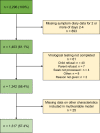Prognostic value of upper respiratory tract microbes in children presenting to primary care with respiratory infections: A prospective cohort study
- PMID: 35552562
- PMCID: PMC9098075
- DOI: 10.1371/journal.pone.0268131
Prognostic value of upper respiratory tract microbes in children presenting to primary care with respiratory infections: A prospective cohort study
Abstract
Background: The association between upper respiratory tract microbial positivity and illness prognosis in children is unclear. This impedes clinical decision-making and means the utility of upper respiratory tract microbial point-of-care tests remains unknown. We investigated for relationships between pharyngeal microbes and symptom severity in children with suspected respiratory tract infection (RTI).
Methods: Baseline characteristics and pharyngeal swabs were collected from 2,296 children presenting to 58 general practices in Bristol, UK with acute cough and suspected RTI between 2011-2013. Post-consultation, parents recorded the severity of six RTI symptoms on a 0-6 scale daily for ≤28 days. We used multivariable hurdle regression, adjusting for clinical characteristics, antibiotics and other microbes, to investigate associations between respiratory microbes and mean symptom severity on days 2-4 post-presentation.
Results: Overall, 1,317 (57%) children with complete baseline, microbiological and symptom data were included. Baseline characteristics were similar in included participants and those lacking microbiological data. At least one virus was detected in 869 (66%) children, and at least one bacterium in 783 (60%). Compared to children with no virus detected (mean symptom severity score 1.52), adjusted mean symptom severity was 0.26 points higher in those testing positive for at least one virus (95% CI 0.15 to 0.38, p<0.001); and was also higher in those with detected Influenza B (0.44, 0.15 to 0.72, p = 0.003); RSV (0.41, 0.20 to 0.60, p<0.001); and Influenza A (0.25, -0.01 to 0.51, p = 0.059). Children positive for Enterovirus had a lower adjusted mean symptom severity (-0.24, -0.43 to -0.05, p = 0.013). Children with detected Bordetella pertussis (0.40, 0.00 to 0.79, p = 0.049) and those with detected Moraxella catarrhalis (-0.76, -1.06 to -0.45, p<0.001) respectively had higher and lower mean symptom severity compared to children without these bacteria.
Conclusions: There is a potential role for upper respiratory tract microbiological point-of-care tests in determining the prognosis of childhood RTIs.
Conflict of interest statement
The authors have declared that no competing interests exist.
Figures
Similar articles
-
Throat swabs in children with respiratory tract infection: associations with clinical presentation and potential targets for point-of-care testing.Fam Pract. 2017 Aug 1;34(4):407-415. doi: 10.1093/fampra/cmw136. Fam Pract. 2017. PMID: 28334924 Free PMC article.
-
Lower respiratory tract infection in the community: associations between viral aetiology and illness course.Clin Microbiol Infect. 2021 Jan;27(1):96-104. doi: 10.1016/j.cmi.2020.03.023. Epub 2020 Mar 31. Clin Microbiol Infect. 2021. PMID: 32244051 Free PMC article.
-
Novel multi-virus rapid respiratory microbiological point-of-care testing in primary care: a mixed-methods feasibility evaluation.Fam Pract. 2021 Sep 25;38(5):598-605. doi: 10.1093/fampra/cmab002. Fam Pract. 2021. PMID: 33684208
-
Assessing the potential of upper respiratory tract point-of-care testing: a systematic review of the prognostic significance of upper respiratory tract microbes.Clin Microbiol Infect. 2019 Nov;25(11):1339-1346. doi: 10.1016/j.cmi.2019.06.024. Epub 2019 Jun 26. Clin Microbiol Infect. 2019. PMID: 31254715 Free PMC article.
-
The TARGET cohort study protocol: a prospective primary care cohort study to derive and validate a clinical prediction rule to improve the targeting of antibiotics in children with respiratory tract illnesses.BMC Health Serv Res. 2013 Aug 17;13:322. doi: 10.1186/1472-6963-13-322. BMC Health Serv Res. 2013. PMID: 23958109 Free PMC article.
Cited by
-
Positive and negative viral associations in patients with acute respiratory tract infections in primary care: the ECOVIR study.Front Public Health. 2023 Nov 24;11:1269805. doi: 10.3389/fpubh.2023.1269805. eCollection 2023. Front Public Health. 2023. PMID: 38074759 Free PMC article.
-
Characterizing acute respiratory infections in primary care for better management of viral infections.NPJ Prim Care Respir Med. 2025 Jun 5;35(1):28. doi: 10.1038/s41533-025-00434-w. NPJ Prim Care Respir Med. 2025. PMID: 40473668 Free PMC article.
-
Using microbiological data to improve the use of antibiotics for respiratory tract infections: A protocol for an individual patient data meta-analysis.PLoS One. 2023 Nov 27;18(11):e0294845. doi: 10.1371/journal.pone.0294845. eCollection 2023. PLoS One. 2023. PMID: 38011202 Free PMC article.
References
-
- Troeger C, Blacker B, Khalil IA, Rao PC, Cao J, Zimsen SRM, et al.. Estimates of the global, regional, and national morbidity, mortality, and aetiologies of lower respiratory infections in 195 countries, 1990–2016: a systematic analysis for the Global Burden of Disease Study 2016. Lancet Infect Dis 2018;18(11):1191–210. doi: 10.1016/S1473-3099(18)30310-4 - DOI - PMC - PubMed
-
- Thornton H V., Turner KME, Harrison S, Hammond A, Hawcroft C, Hay AD. Assessing the potential of upper respiratory tract point-of-care testing: a systematic review of the prognostic significance of upper respiratory tract microbes. Clin Microbiol Infect 2019;25:1339–46. doi: 10.1016/j.cmi.2019.06.024 - DOI - PMC - PubMed
Publication types
MeSH terms
Grants and funding
LinkOut - more resources
Full Text Sources
Medical


